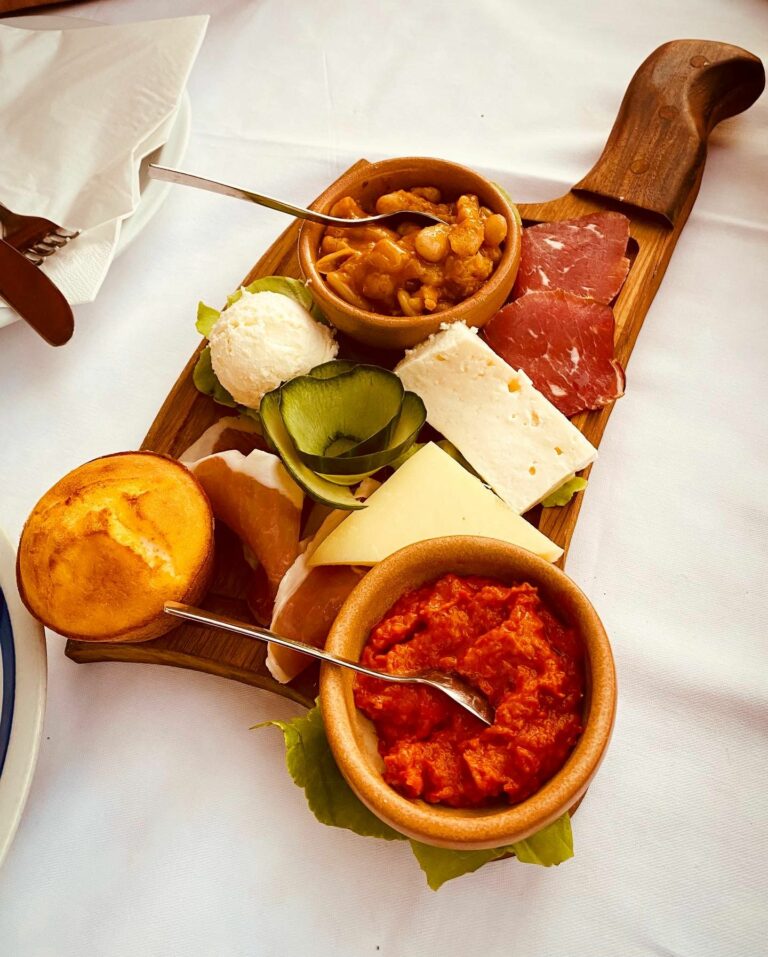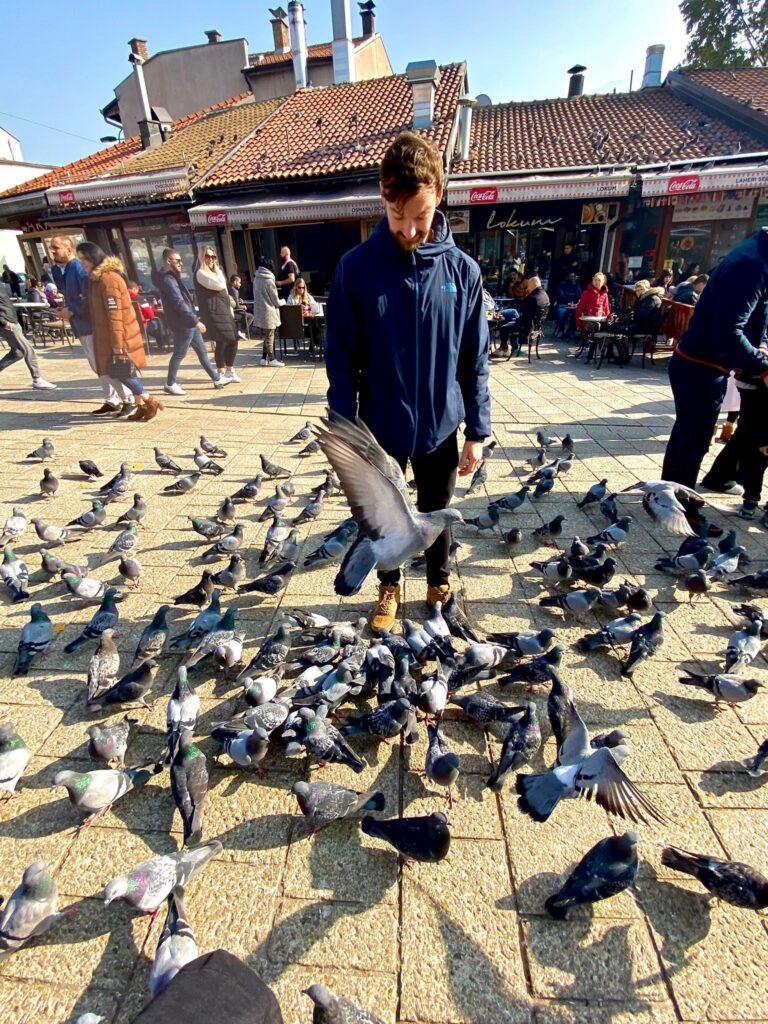Hiking St. Cuthbert’s Way: The Ultimate Guide
I hiked the entirety of St. Cuthbert’s Way a few months ago.
One of the most underrated long-distance trails in the UK, it’s brilliant, it’s challenging, and it’s way more beautiful than most people realize.
So in this ultimate guide, I’ve brought you everything you need to know about the hike, including top tips, things to look out for, and my suggested four-day itinerary.
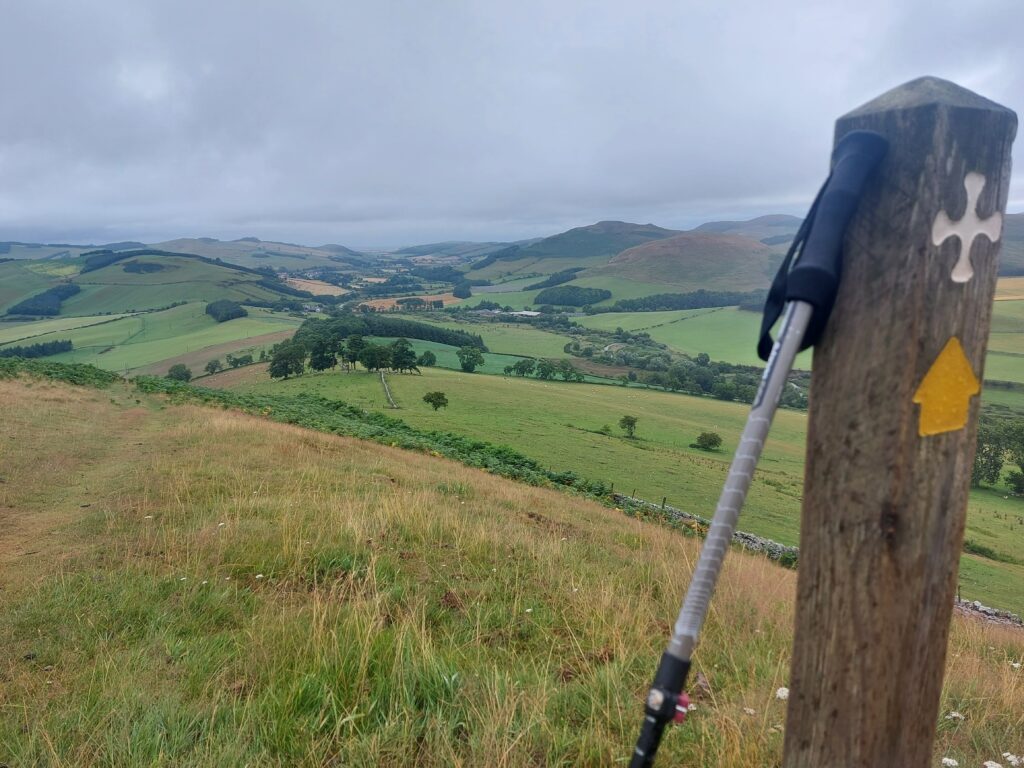
Contents
What is St. Cuthbert’s Way, and Where Will it Take Me?
St. Cuthbert’s Way is a 62-mile (100km) long-distance walk from Melrose (in the very south of Scotland) to Holy Island, a weird little island off the east coast of northern Northumberland (in England).
The walk goes over the Cheviots (some of the most underrated mountains in England), and through loads of lovely towns, villages and farms. It’s an ancient pilgrimage route, covering some of the significant places from St. Cuthbert’s life (he was some old Anglo-Saxon saint who lived and died in the 7th century).
But you’ll still enjoy the walk if don’t care about all the religious stuff (I don’t either). I’m not remotely bothered about St. Cuthbert, but I like mountains and hiking and nice views. So if you like all those things, get yourself on St. Cuthbert’s Way! I reckon it’s the best long-distance hike in Northumberland (I’ve listed lots of my other favorite Northumberland hikes here).
I did St. Cuthbert’s Way with a big doy-brain called Tom, one of my friends. We did it over four days, and used public transport to get to the start of the walk, and home from the end of the walk. We’re both originally from Newcastle (and were both living there at the time), so that made things nice and easy.
Along St. Cuthbert’s Way, the views are ridiculously beautiful, and you’ll pass through load of landscapes you’ve probably never heard of. For me, St. Cuthbert’s Way is better, more interesting and more attractive than Hadrian’s Wall. And best of all, you won’t see loads of people along the way.
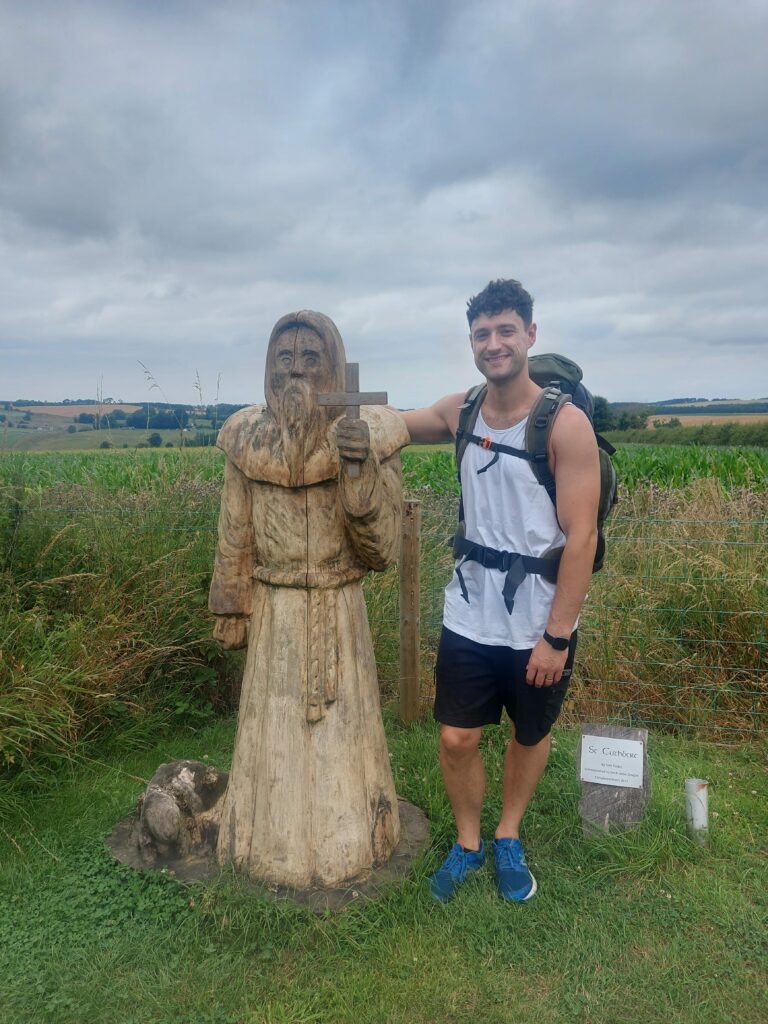
St. Cuthbert’s Way: My Suggested 4-Day Itinerary
Day 1: Melrose to Ancrum
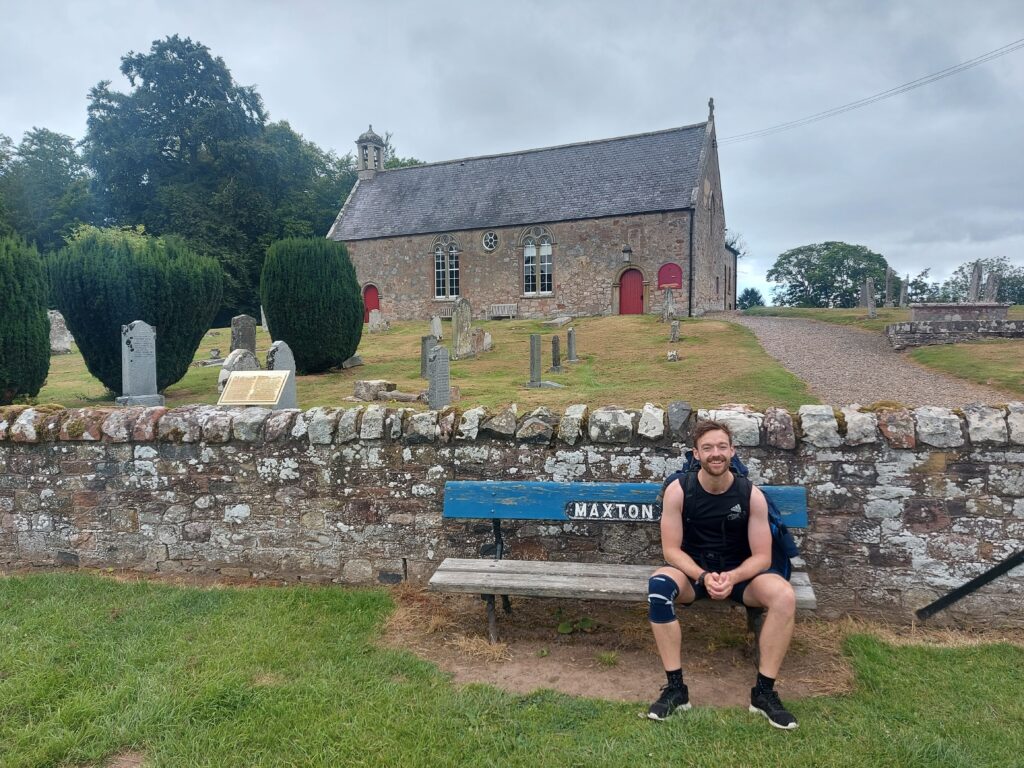
The start of the official walk is at Melrose Abbey, where St. Cuthbert once worked or ate a meal or something else the guidebook said that I don’t remember and don’t care about.
Anyway, you start the day by walking south from Melrose Abbey towards the Eildon Hills. It’s a big hefty start to the day, cos it’s a steep ascent right out of Melrose. But don’t worry – once that bit’s over, it’s downhill again, then it’s basically flat walking all day. So, in short: a steep start followed by lots of easy stuff.
The views from the Eildon Hills are pretty good, but they’re nothing compared to the much better stuff you still have to come. Today, you go through St. Boswells (a really nice place to stop for a coffee and a cake and all that) and lots of farms and fields. it’s a pretty day, but it’s nothing special (yet).
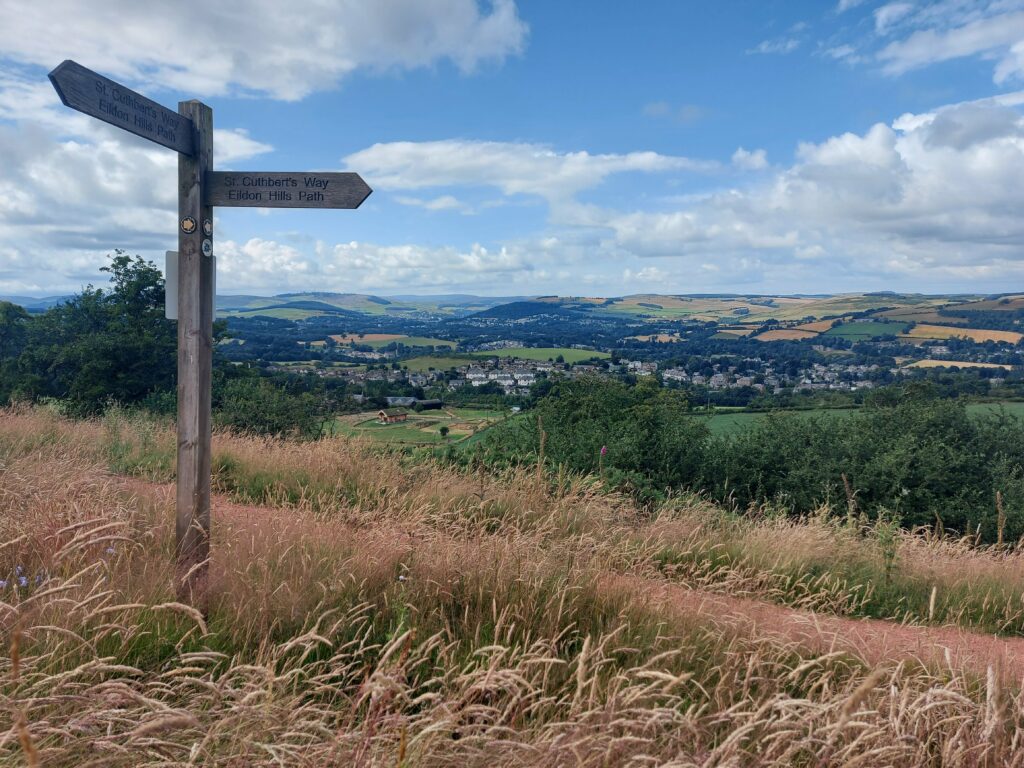
There are very few accommodation options in Ancrum, or in nearby Bonjedward (when I did the walk, there were literally none – or at least none that were available).
So here’s what I did (and what lots of other people do) instead: when you get to Ancrum, you can get the bus to Jedburgh, a pretty big town just a 30-minute bus ride away. It has loads of pubs, cafes, restaurants and accommodations, so it’s a sensible place to overnight. And then the next morning, you can just get the bus from Jedburgh back to Ancrum and start again. Easy eh!
Day 2: Ancrum to Kirk Yetholm
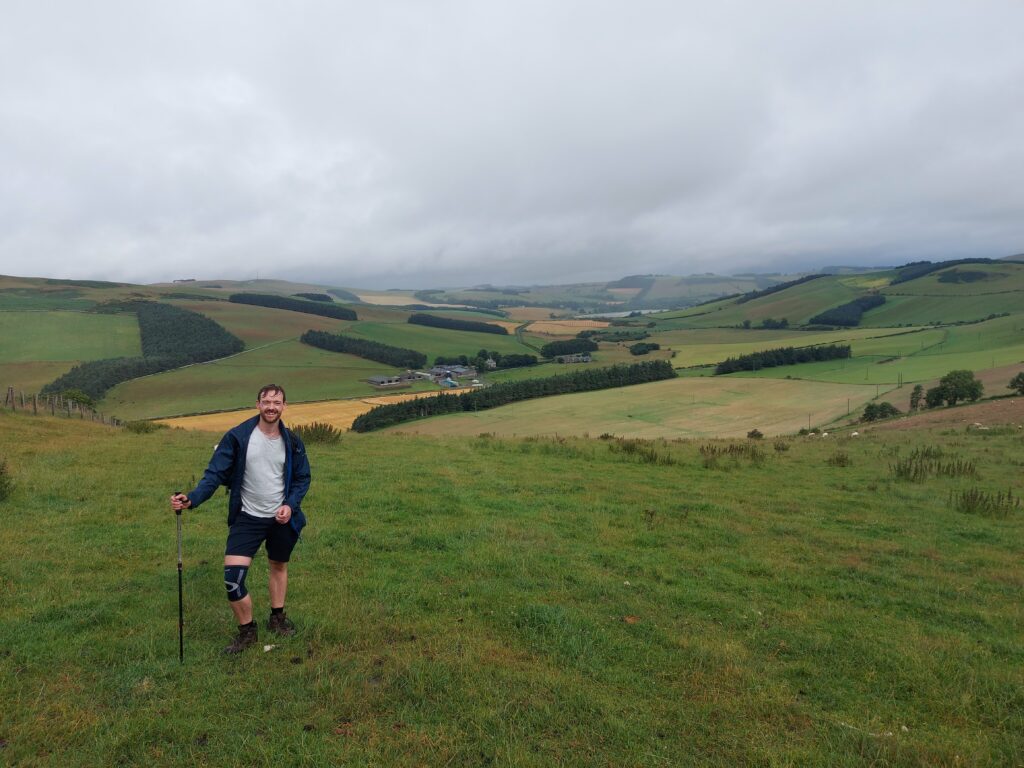
Today, you hit the highest point of the walk (Wideopen Hill, which sits at 386 meters/1,207 feet). Loads of the landscapes along St. Cuthbert’s Way are remote, but the hilly sections of today are maybe the most remote.
After this section, you’ll hit Cessford Castle and Morebattle (Morebattle is a perfect lunch stop), then you’ll wander along lots of tarmac and farms into Kirk Yetholm and Town Yetholm. Both have lots of places to eat, drink and sleep.
This is a really pretty day, with lots of excellent views. The best bit is definitely coming down towards Cessford and Morebattle through a big valley, where you’ll see the most-photographed part of the walk (the bit I photographed for the very first picture on this post, cos I have no imagination or original thoughts).
Day 3: Kirk Yetholm to Wooler
This is the prettiest day. By far.
It’s also ridiculously beautiful, and massively remote. You’ve probably heard of the Cheviot, and Hedgehope, and the other famous parts of the Cheviots.
But on this stretch of the walk, you don’t hit the most famous sights. Instead, you wander past loads of hills and valleys you probably haven’t heard of (and that I don’t remember the name of).
Early on in the day, you’ll wander through the border between Scotland and England (as you can see in the picture below). I didn’t think there’d be any signs to indicate the crossover, but there is. There’s no border patrol though, perfect if you’re an illegal immigrant making a dramatic escape from one British country to another. After you’ve crossed the little stile that represents the border, you’ll be in the Cheviots – and you basically stay there until you get to Wooler.
So for around 12 miles (19km), you’re right in the middle of some of Northumberland’s most remote and rural hills. You’ll see Hethpool Linn (a little waterfall, if you’re into that sort of thing), lots of heather, and about ten million sheep. And lots of lots and lots of nice views.
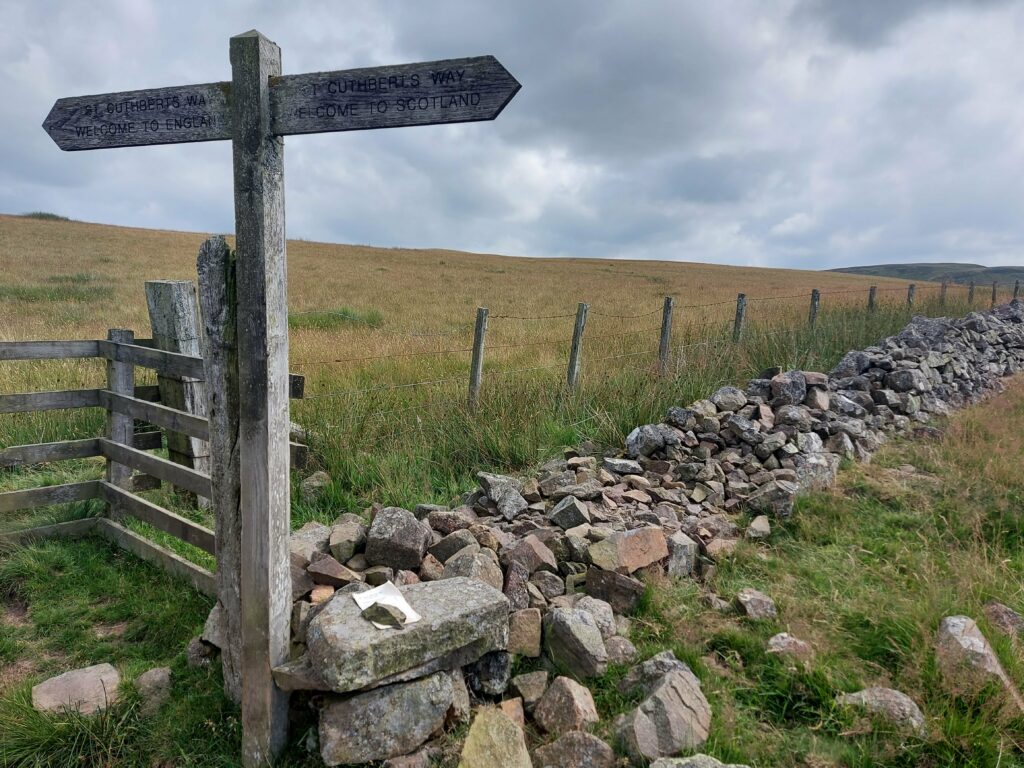

Between Kirk Yetholm and Wooler, you’re not going to pass any big shops or cafes or anything. So take a packed lunch kid, cos you’re gonna need it. Oh, and carry enough water.
This day is also the most challenging, because you get lots of ascents and descents.
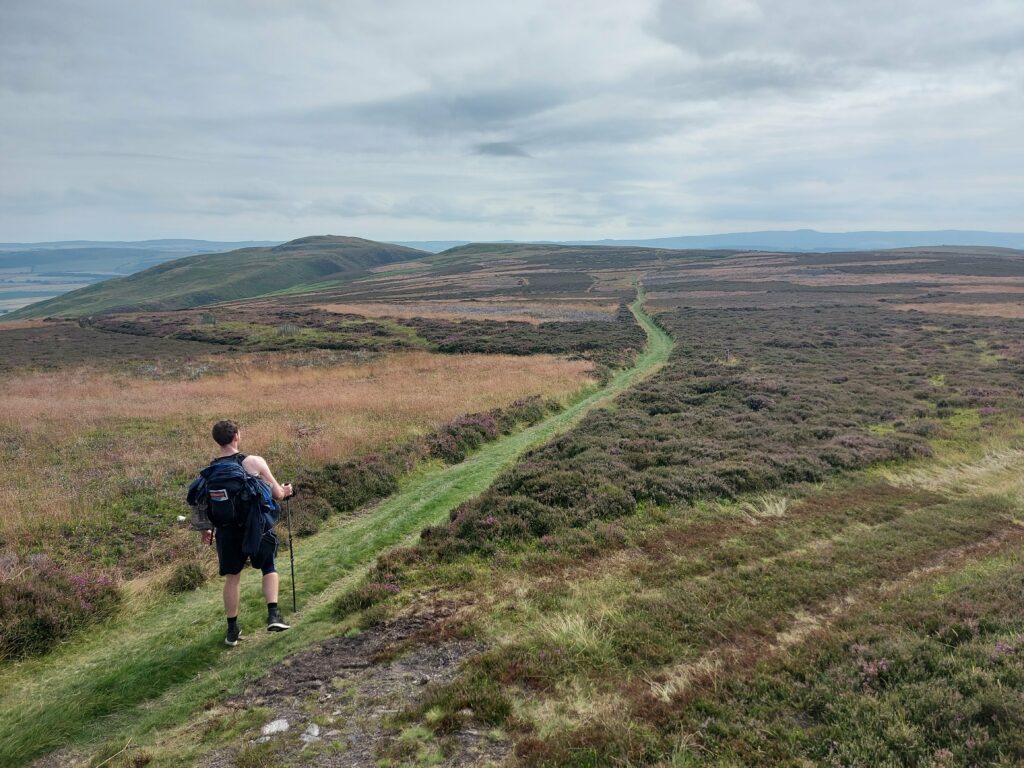
When you get to Wooler, make sure you go out for some food and a couple of pints and that. A relatively popular tourist town, people come for easy access to the Cheviots, and it’s a nice little place to spend some time.
Day 4 Wooler to Holy Island
Today’s gonna be a long ol’ day. Your longest by a long way, clocking in at around 19 miles (31km).
You can break it up into two days (by stopping off in or around Fenwick), but it’s a pretty flat day, so it’s definitely achievable in one big lovely slog if you get up early, and if the tide times allow (more on that in a minute).
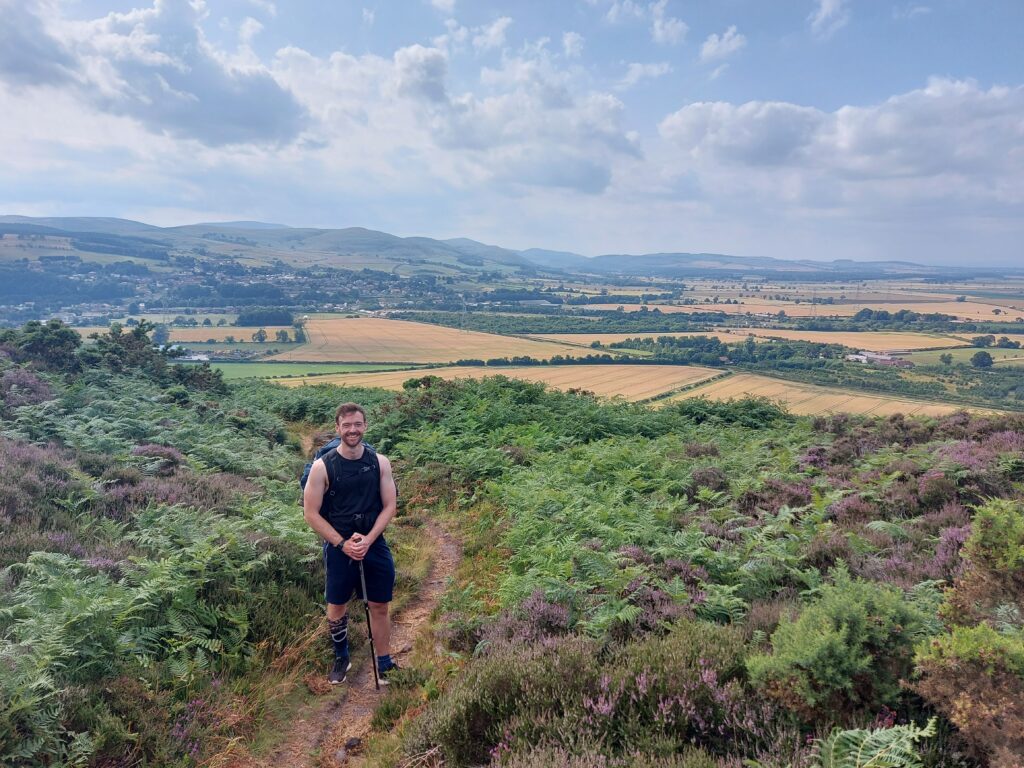
Today, you’ll walk out of Wooler, through lots of farmland, past St. Cuthbert’s Cave (some old cave where St. Cuthbert’s dead body was stored for a while or something – it’s nothing special), past some nice views (not as good as previous days though), and over to Holy Island.
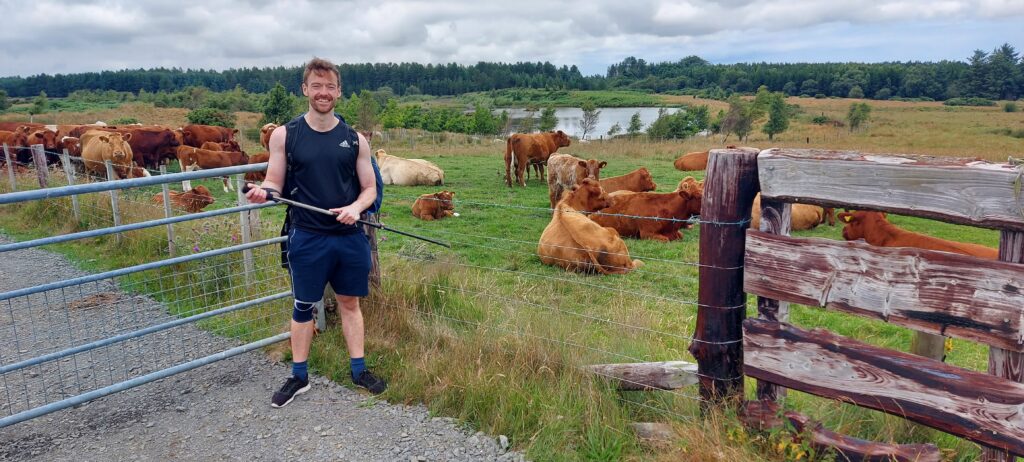
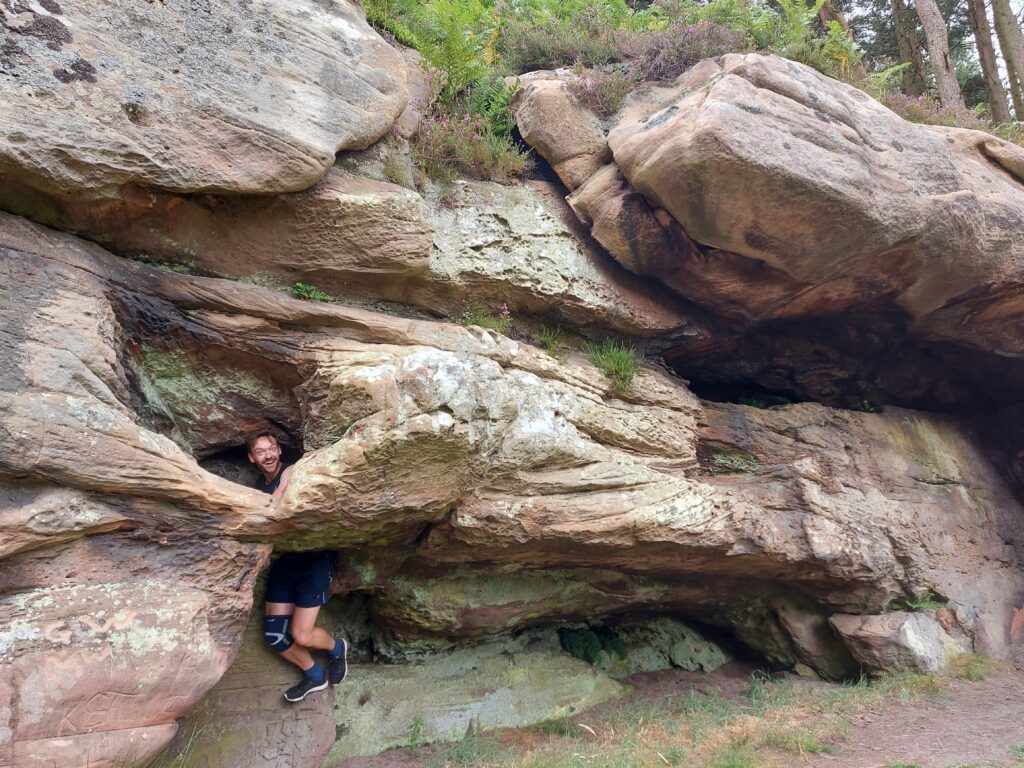
When you get to Beal, on the mainland, it’s time to cross over to Holy Island. Here, you’ll wander over wet sand to reach Holy Island. Lots of people do it barefoot, cos it’s some sort of tradition or something.
I’m gonna be honest here: Me and Tom didn’t bother walking over to Holy Island. We had to be home on a certain day, and cos of the tide times, we wouldn’t have been able to cross over to Holy Island and then back again in time. So we didn’t. But we’re from the local area and we’ve both spent loads of time walking, cycling and exploring in and around Holy Island. What a terrible excuse eh.
If you’re not a fast walker, you should ignore my advice here and make your 4-day walk into a 5-day walk instead. On your fourth night, stay in Fenwick (or in that general area). Then on your last day, wander over to Holy Island. If you’re not a fast walker, and you follow my 4-day plan, you might end up getting washed away by the rising tides when you try to cross into Holy Island.
Top Tips for Hiking St. Cuthbert’s Way
- You don’t need a map. People who say you need a map are little panicky-poo-poos, because the whole route is really well signposted. If you want to know about the places you’re visiting, and a bit of historical context, and all that stuff, I recommend this book, which I took with me. It even has little maps in it. Lucky you!
- Be careful about checking the tides for when you get to Holy Island. Time it wrong, and you might unironically get swept away by the waves. Note to readers: dying is not a good way to finish your walk. Follow the instructions on this site very carefully.
- There’s a good chance that the weather will be crap, even in summer. Weather in this part of the world is unpredictable, and ‘summer’ doesn’t necessarily mean ‘dry and warm.’ So pack some waterproof stuff, no matter what time of year you’re walking.
- You can walk both west to east (as I’ve described) and east to west. When I did the hike, I didn’t actually follow the itinerary I’ve outlined above (what a big fat hypocrite). That’s because, like I said, me and Tom are from the local area, and we don’t care about St. Cuthbert, and it was easier to use public transport in the reverse direction. What I’m saying is, although it makes more sense to walk west to east, you don’t need to.
- A lot of the walk is remote and rural, so make sure you always carry enough food and water. You’re not gonna find a big supermarket in the middle of the Cheviots.
- Keep your eyes open for nature, cos there’s lots of it. Some of the local creatures and critters you might see include adders (yeah, seriously – don’t let them bite you) slow-worms (horrible shiny legless lizards), wild goats, and loads of big birds. This part of Northumberland is home to a huge number of rare animals.
- You don’t need to be massively fit to tackle the challenge. If you can walk ten miles (16km) in a day, you can do this. Yeah, there are challenging sections, but you can just take your time. I believe in you.
Can I Access St. Cuthbert’s Way With Public Transport?
Yeah, you can. If you’re coming from Newcastle or Berwick (or probably even Edinburgh), it’s easy to use public transport to reach both ends of the trail. It takes a while, cos not many places are directly connected to Melrose or Holy Island, but it’s possible.
If you’re traveling into the area to tackle the walk, Berwick is the best access point for both ends of the trail. Newcastle is also a pretty good access point (and a great place to spend a couple of days, especially if you like getting smashed at the weekend), but it’s further from both Melrose and Holy Island.
Good Accommodation Options for St. Cuthbert’s Way
Here are my top recommendations:
- Melrose: I didn’t stay in Melrose, but the Townhouse Hotel and the Station Hotel are both popular and well-reviewed – and they both include breakfast!
- Jedburgh (if you stay here instead of Ancrum, like I did): We stayed at St. Ola (brilliant breakfast, and owned by a really nice couple), but Meadhon Guesthouse is also a really popular (and central) place.
- Kirk Yetholm: We stayed in the Plough Hotel (really central and welcoming, and they serve brilliant dinners). We wanted to stay in the Kirk Yetholm Hostel, but it’s really popular, so it was fully-booked.
- Wooler: We stayed at Wooler Hostel & Shepherd’s Huts (a really lovely place to stay, and good for families, couples, solo travelers, and everyone in between). The Black Bull Inn is slightly more central, and inside of a pub (which is always nice, cos everyone likes a few beers after a long day of walking).
- Holy Island: I’ve never actually stayed on Holy Island, but Belvue Guesthouse and Manor House Hotel both have really good reputations.
- Newcastle (if Newcastle is your base): You won’t get much luxury on your trip, so you might aswell enjoy some now. Two comfy and central (but budget-friendly!) options are Holiday Inn Express and Jurys Inn.
- Berwick (if Berwick is your base): Two great cozy but affordable hotels are the Premier Inn and the Queen’s Head Hotel. The first is a chain, while the latter is a little more homely and wholesome.
Some people camp along St. Cuthbert’s Way. I like camping, but on a multi-day walk, I can’t be bothered to carry all the equipment you need to camp, so I didn’t bother. There are some campsites along the route, and there are loads of places to wild camp (wild camping is illegal in England, but I wouldn’t let that stop me – just be a responsible camper).
St. Cuthbert’s Way: Final Thoughts
There you are boys and girls – that’s everything you need to know about St. Cuthbert’s Way. Thanks for reading! And if you have any top tips I’ve missed out (or any questions!) stick them in the comments below.
See you next time.


